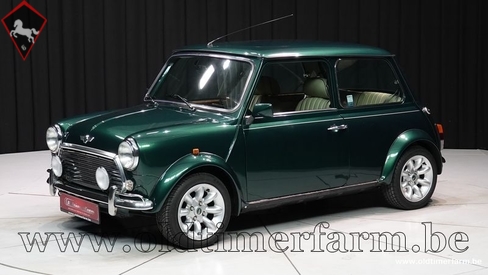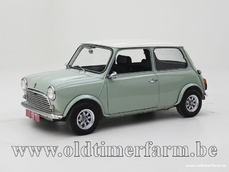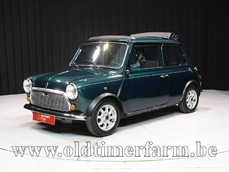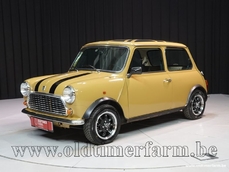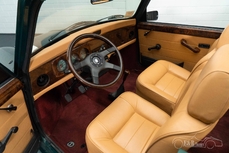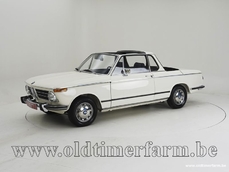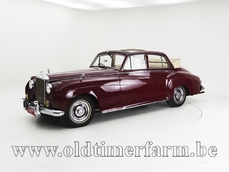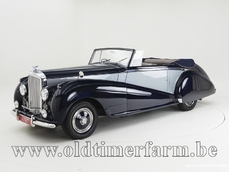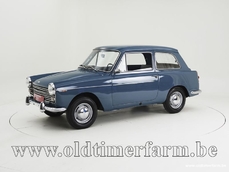Mini 1300 MPI Sportspack '97 1997
General description :
Issigonis' friend John Cooper, owner of the Cooper Car Company and designer and builder of Formula One and rally cars, saw the potential of the Mini for competition. Issigonis was initially reluctant to see the Mini in the role of a performance car, but after John Cooper appealed to BMC management, the two men collaborated to create the Mini Cooper, a nimble, economical and inexpensive car. The Austin Mini Cooper and Morris Mini Cooper debuted in 1961. The original 848 cc engine from the Morris Mini-Minor was given a longer stroke to increase capacity to 997 cc, boosting power from 34 bhp to 55 bhp (25 to 41 kW). The car featured a racing-tuned engine, twin SU carburettors, a closer-ratio gearbox and front disc brakes, uncommon at the time in a small car. One thousand units of this version were commissioned by management, intended for and designed to meet the homologation rules of Group 2 rally racing. The 997 cc engine was replaced by a shorter stroke 998 cc unit in 1964. A more powerful Mini Cooper, dubbed the "S", was developed in tandem and released in 1963. Featuring a 1071 cc engine with a 70.61 mm bore and nitrided steel crankshaft and strengthened bottom end to allow further tuning; and larger servo-assisted disc brakes, 4,030 Cooper S cars were produced and sold until the model was updated in August 1964. Cooper also produced two S models specifically for circuit racing in the under 1000cc and under 1300cc classes respectively, rated at 970 cc and a 1275 cc, both with the 70.61mm bore and both of which were also offered to the public. The smaller-engine model was not well received, and only 963 had been built when the model was discontinued in 1965. The 1275 cc Cooper S models continued in production until 1971. Sales of the Mini Cooper were as follows: 64,000 Mark I Coopers with 997 cc or 998 cc engines; 19,000 Mark I Cooper S with 970 cc, 1071 cc or 1275 cc engines; 16,000 Mark II Coopers with 998 cc engines; 6,300 Mark II Cooper S with 1275 cc engines. There were no Mark III Coopers and just 1,570 Mark III Cooper S's. The Mini Cooper S earned acclaim with Monte Carlo Rally victories in 1964, 1965 and 1967.[29] Minis were initially placed first, second and third in the 1966 rally as well, but were disqualified after a controversial decision by the French judges. The disqualification related to the use of a variable resistance headlamp dimming circuit in place of a dual-filament lamp. It should be noted that the Citroën DS that was eventually awarded first place had illegal white headlamps but escaped disqualification. The driver of the Citroën, Pauli Toivonen, was reluctant to accept the trophy and vowed that he would never race for Citroën again. BMC probably received more publicity from the disqualification than they would have gained from a victory. In 1971, the Mini Cooper design was licensed in Italy by Innocenti and in 1973 to Spain by Authi (Automoviles de Turismo Hispano-Ingleses), which began to produce the Innocenti Mini Cooper 1300 and the Authi Mini Cooper 1300, respectively. The Cooper name disappeared from the UK Mini range at this time, as British Leyland (as it was by then) supposedly did not want to pay John Cooper royalties for the use of his name, so it was not seen again on Minis for nearly 20 years! A new Mini Cooper named the RSP (Rover Special Products) was briefly relaunched in 1990-1991, with slightly lower performance than the 1960s Cooper. It proved so popular that the new Cooper-marked Mini went into full production in late 1991. From 1992, Coopers were fitted with a fuel-injected version of the 1275 cc engine, and in 1997 a multi-point fuel injected engine was introduced, along with a front-mounted radiator and various safety improvements. Specifications Bodywork Length : cm (in): 305 (120.3) Width : cm (in): 144 (56.7) Height : cm (in): 134 (52.8) Wheelbase : cm (in) : 203.5 (80.1) Weight: kg (lb) : 690 (1521) Mechanics. Displacement : straight 4 1275 cc (78 ci), front mounted Valve gear : 8 Fuel system : sequential point fuel injection Gearbox : 4 speed manual Drive wheels : front wheel drive Maximum power : 63 bhp at 5550 rpm Maximum torque : 95 Nm at 3000 rpm Maximum speed : 160 km/h (100 mph)
http://www.oldtimerfarm.be/en/collection-cars-for-sale/5432/mini-13-mpi-sportspack-97.php
1997 Mini 1300 MPI Sportspack '97 is listed sold on ClassicDigest in Aalter by Oldtimerfarm Dealer for €15750.
Car Facts
Car type : Car Make : Mini Model : 1300 Model Version : MPI Sportspack '97 Engine size : 0.0 Model Year : 1997 Location : Aalter
Sold
Seller Information
Sold
People who viewed this Mini 1300 also viewed similar Mini listed at ClassicDigest
Other cars listed for sale by this dealer
About Mini
The Mini is indeed an iconic car that revolutionized the automotive industry and set the standard for compact cars. Here's a brief history of the Mini, its development, and some of the key versions of the classic Mini:1. Origins and Development:
Founder and Designer: The Mini was designed by Sir Alec Issigonis, a British-Greek automotive engineer.
Introduction: The Mini was officially introduced by the British Motor Corporation (BMC) in 1959.
Innovative Design: Issigonis' design featured a transverse engine, front-wheel drive, and a compact layout, maximizing interior space.
2. Classic Mini Models:
Mark I (1959–1967):
Mini Cooper (1961): The performance-oriented Cooper version, developed in collaboration with racing legend John Cooper, was introduced.
Mark II (1967–1970):
Minor design changes, including a redesigned grille.
Mark III (1969–2000):
Introduction of the Clubman and Clubman Estate variants.
Further design updates, including a more rounded front grille.
3. Mini Cooper S:
Performance Variant: The Mini Cooper S, particularly the Mk I version, became famous for its success in rally racing, winning the Monte Carlo Rally multiple times.
4. Mini Moke:
Utility Vehicle: The Mini Moke was a utility vehicle based on the Mini platform, featuring an open-top design. It gained popularity in various warm-weather locations.
5. Mini Countryman:
Extended Version: The Mini Countryman was introduced as a longer and more practical version of the classic Mini. It featured a rear-hinged door for easier access to the rear seats.
6. End of Production:
Later Years: Production of the classic Mini continued until the year 2000.
Final Editions: The last classic Mini rolled off the production line on October 4, 2000, marking the end of an era.
7. BMW Era and New MINI:
BMW Acquisition: BMW acquired the rights to the Mini brand and introduced the new MINI in 2001.
Modern Interpretation: The new MINI retained some design cues from the classic but featured modern technology and safety standards.
8. Legacy and Influence:
Cultural Icon: The classic Mini became a cultural icon, symbolizing British design and efficiency.
Influence on Compact Cars: The Mini's layout and design principles influenced the development of compact cars for decades to come.
The Mini's impact on the automotive industry goes beyond its compact size; it represents a design philosophy that prioritizes efficiency, space utilization, and a fun driving experience. The classic Mini's enduring popularity is a testament to its timeless design and innovative engineering.
